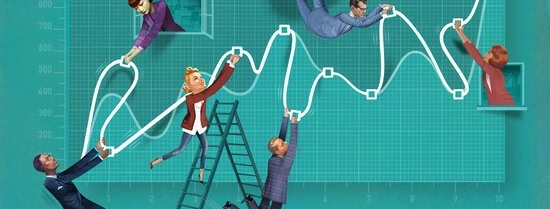Macroeconomic forecasts can be the outcome of a judgmental adjustment to a forecast from an econometric model. The size, direction, and motivation of the adjustment are not known as usually only the final forecast is available. This prevents learning from forecast errors. Recently, I proposed a formal method to include judgment, which makes the combined forecast reproducible (for more information, see end). As an illustration, a forecast from a simple time series model is only modified when the value of a dynamic factor, estimated from a multitude of variables, exceeds a user-specified threshold. Forecasting annual real GDP growth in 52 African countries provides an illustration.
Macroeconomic forecasts are a key input to macroeconomic policies issued by governments and central banks. These forecasts typically concern important variables like growth in real Gross Domestic Product (GDP), unemployment and inflation.
The intricacy of predicting turning points
Econometric models can provide the basis for macroeconomic forecasts. In reasonably prosperous times these models tend to do well in terms of forecast accuracy. Unfortunately, when times radically change, most econometric models are not qualified to predict for example turning points, and human intervention may direct the forecasts in the proper direction. It is thus common practice to base macroeconomic forecasts on the outcome of an econometric model combined with expert judgment, or sometimes even to use no econometric model at all. Judgmental adjustment can lead to more accuracy.
‘When times radically change, most econometric models are not qualified to make predictions’
In many cases in practice, only the final forecast is available, and it is unknown how the underlying model looked like, how adjustment took place, and what was the precise motivation for such adjustment. This can be disadvantageous if one wants to learn from forecast errors. Consider for example the 2008/2009 recession. In those years for the USA, real GDP growth was -0.3 and -2.8, respectively. In the June 2008 survey of the Consensus Forecasters the average quote for 2008 was 1.5 (ranging from 0.8 to 1.9), while the average quote for 2009 was 1.7 (with a highest and lowest score of 3.1 and 0.6, respectively). Even in the November 2008 survey, the average quote for the very same year, 2018, was 1.4 (with high and low 1.5 and 1.3, respectively), whereas the average quote for 2009 now was -0.6 (with individual quotes ranging from 1.2 to -2.1). Apparently, either econometric model forecasts were off track or expert adjustment or both. Unfortunately, this is unknown.
‘In many cases in practice, only the final forecast is available, and it is unknown how the underlying model looked like’
Formalising judgmental adjustment
In my recent research, I propose a formal way of documenting the creation of a judgmentally adjusted forecast. This methodology is illustrated for a simple time series model (as “the model”) and the outcome of a factor analysis of a range of potential predictor variables, which will be added to the model forecast (as “judgmental adjustment”) only when it exceeds thresholds. In the paper the focus is on a setting where there are many predictors. More precise, the aim is to forecast annual real GDP growth in each of 52 African countries, where there are data since 1960. The predictors are the growth rates of the other countries. The variables are summarised in dynamic factors, to be estimated from the data, and they only enter the forecast equation, which is based on a simple autoregressive model, when their values pass some pre-set threshold, based on the standard deviation of the estimated factors. This way, judgmental adjustment is formalised and as such one can learn from past forecast errors.
Bio
Philip Hans Franses (1963) is Professor of Applied Econometrics and Professor of Marketing Research, both at the Erasmus University Rotterdam. As Adjunct Professor he is affiliated with the University of Western Australia, Chiang Mai University in Thailand and the Anton De Kom University in Suriname. His research interests concern the development and application of econometric methods for relevant, meaningful and interesting problems in marketing, finance and macro-economics.
Downloads
- More information
The full paper has been published in a special issue (2021) of the Journal of Quantitative Economics in honour of the late Professor A.L. Nagar. Professor Nagar was affiliated with our Econometric Institute, where he worked on this doctorate thesis under the supervision of Henri Theil and graduated in 1959. You can download the paper above.

